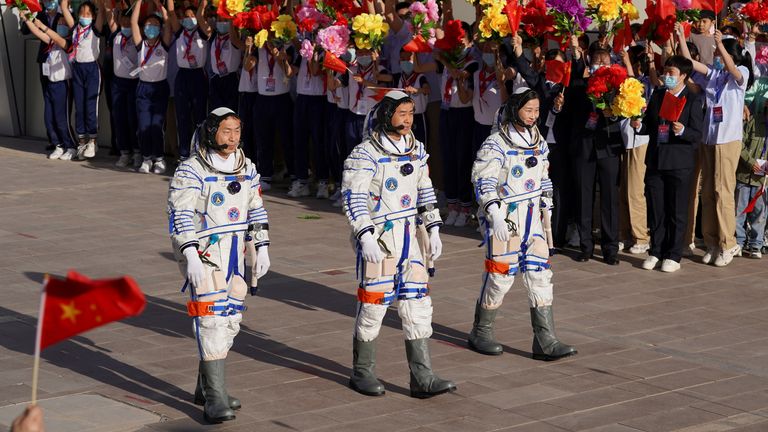[ad_1]
China has launched three astronauts to its uncompleted space station for six months of construction work.
The crew are Chen Dong, Can Xuzhe, and Liu Yang – who was the first Chinese woman in space after a previous mission in 2012.
They will work to complete the Tiangong space station by the end of this year, installing two lab modules at opposite sides of the outpost, giving it a T-shape.
Assembly of the orbiting space station, which will be roughly a fifth of the size of the ISS, began last April and is expected to be completed in November after 11 launches.
China is not allowed to be involved in the ISS after to laws passed by US Congress restricting NASA’s co-operation with Beijing due to the secrecy of its space programme and its close ties to the country’s military.
US caution regarding China’s space ambitions became law in 2011, through the so-called Wolf Amendment.
Congress banned NASA from using government funds to engage in direct, bilateral co-operation with either the Chinese government or any organisations affiliated with the Chinese government.
The law even prohibits NASA from hosting Chinese delegates at any of its facilities without authorisation from Congress and the Federal Bureau of Investigation, which leads on counter-espionage.
The China Manned Space Agency CMSA has “guaranteed” the participation of foreign astronauts in the Tiangong programme.
Last year, a government research organisation in China outlined plans to design and build “ultra-large” spacecraft, potentially miles-wide, that would be assembled piecemeal in space.
Constructing large facilities in space has taken place before, with the ISS requiring 40 assembly flights and more than a decade to build.
But the enormous constructions proposed by the National Natural Science Foundation of China would eclipse the ISS considerably, which only measures 357 feet end-to-end, and could take decades and potentially centuries to build.
These constructions are described as “major strategic aerospace equipment for the future use of space resources, exploration of the mysteries of the universe, and long-term habitation in orbit,” by the NSFC.
[ad_2]


